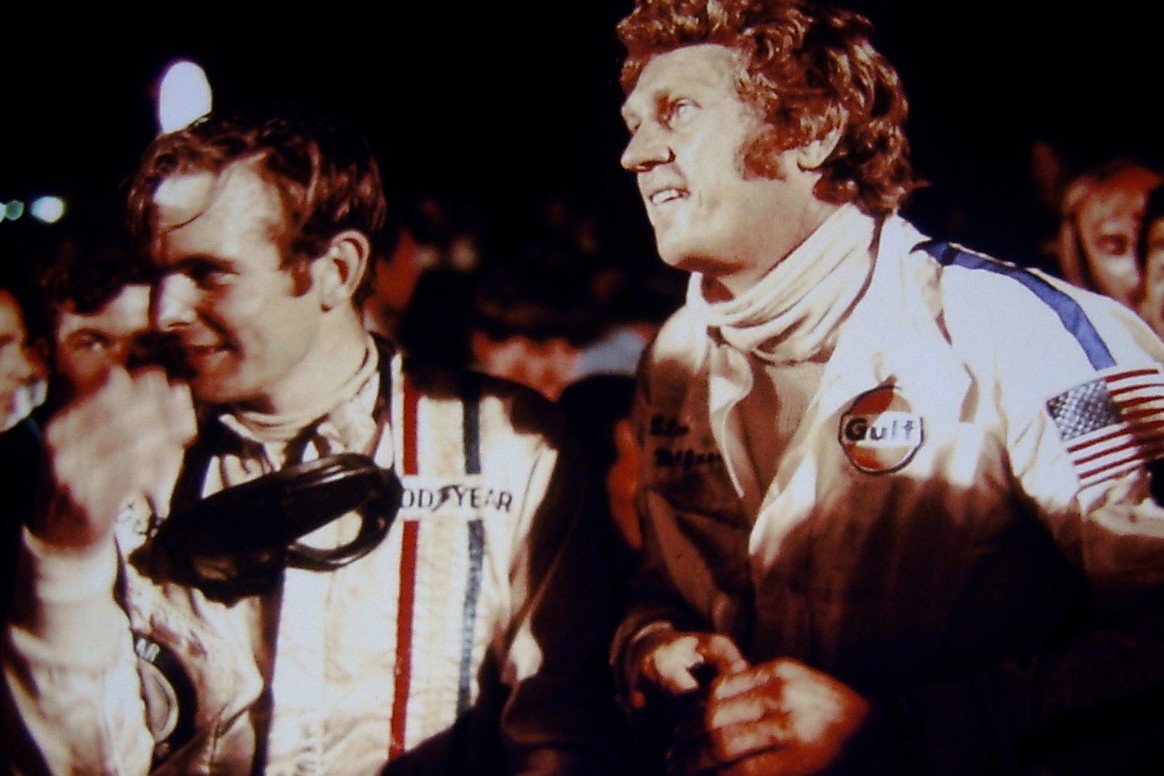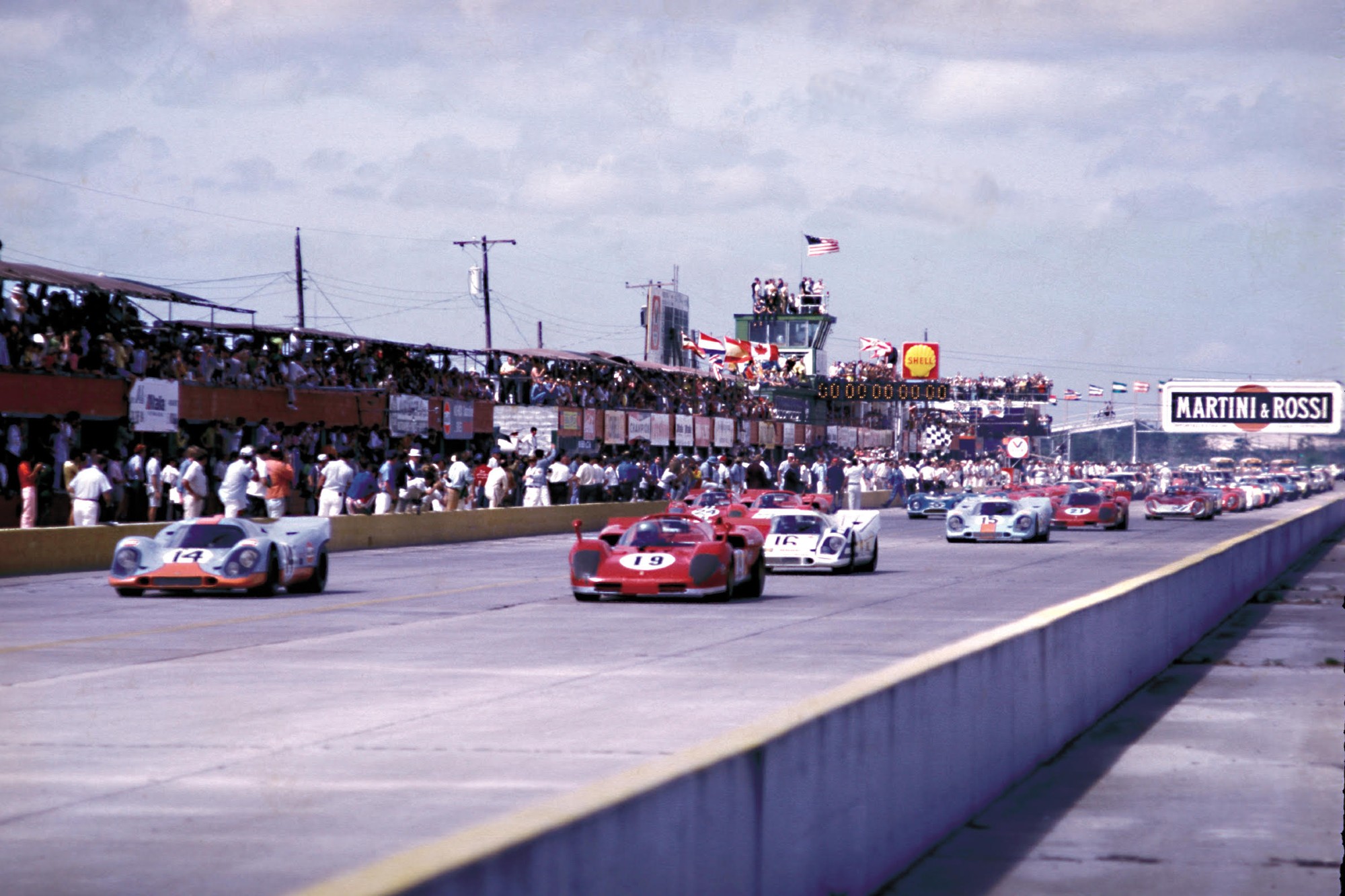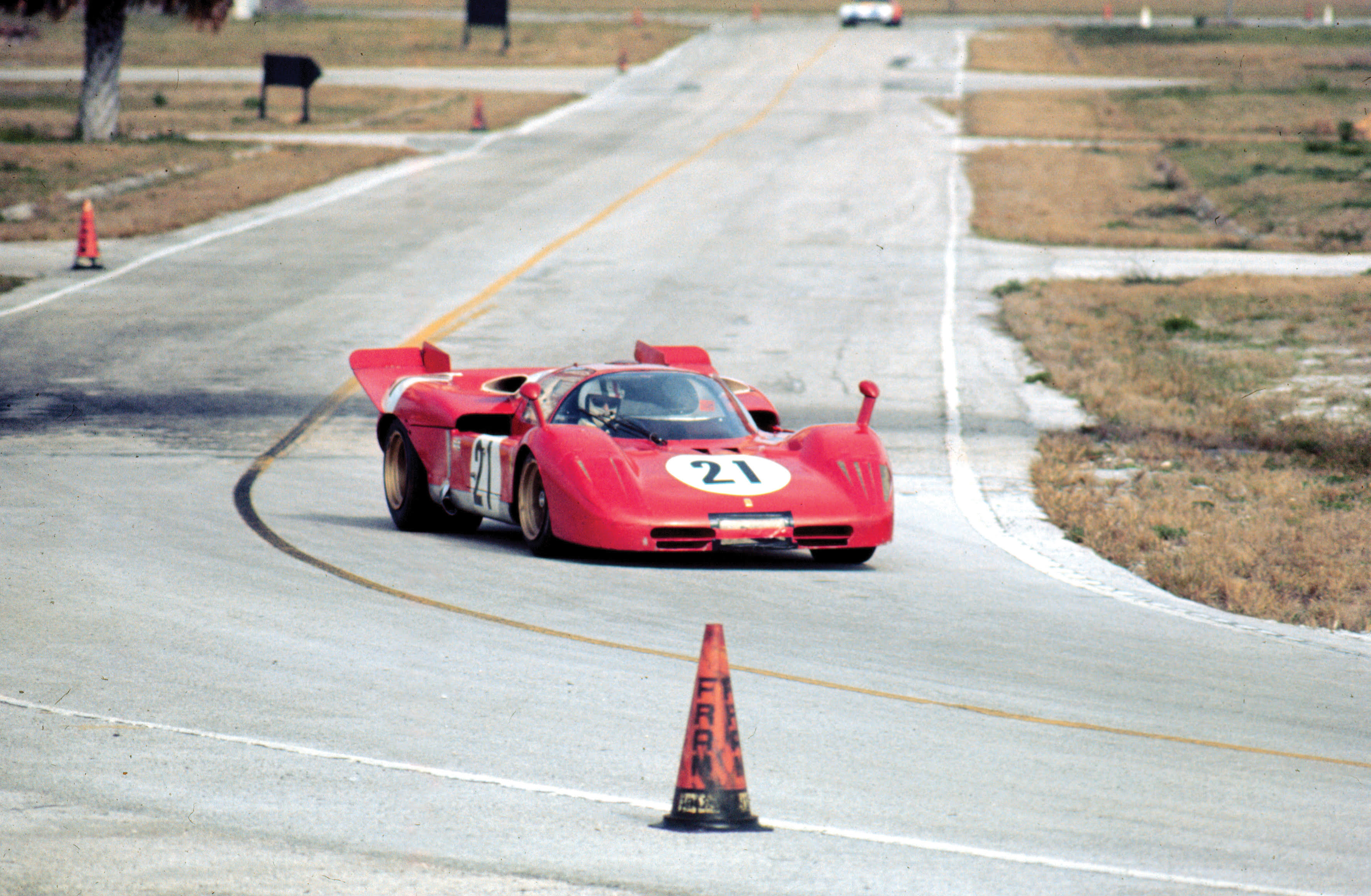The King of Cool. To get that nickname you need to do something like…break from filming Hollywood blockbusters, crash in a motorcycle race breaking six bones in your foot, and then join a Formula 1 race winner and nearly win one of the biggest races in sports car racing in inferior machinery. That just about sums up the 1970 12 Hours of Sebring for The Great Escape, Bullitt, and The Thomas Crown Affair star Steve McQueen.
At this point, McQueen was arguably the biggest film star in the world. Everything he touched pre-1970 turned to gold, and later in the decade, he would go on to become the highest-paid movie actor in the world. From a broken home in Missouri to being recognised everywhere, McQueen was the anti-hero 1960s and 70s loved.
He had begun racing in the previous decade and was somewhat successful in a Mini in the British Touring Car Championship, as well as regularly racing bikes in the US. His love for racing led to a plan to make a film about Formula 1, but that was shelved when filming for The Sand Pebbles – for which McQueen would receive his only Academy Award nomination – was delayed, and John Frankenheimer beat McQueen to the punch with the film that would become Grand Prix. McQueen was bitter about the whole thing.
Annoyed but unwavering in his want to put motorsport on the big screen (his way), a plan to film Le Mans was hatched, launching McQueen into the world of sportscar racing with his own company, Solar Productions. The original plan was for McQueen to race a top-line Porsche 917K alongside then single Formula 1 champion Jackie Stewart in 1970, but famously the entry was rejected – McQueen failed to obtain insurance – and instead a camera car was placed in the race. More on that car and its Sebring antics shortly.
Sebring hasn’t changed much, but back in 1970 its runway road surface left a lot to be desired – and the toll it took on the machinery more than made up for not being a full 24 hour race and made a worthy challenge for the large contingent sent from Germany and Italy
It was a brilliant era to place a Le Mans movie. As the recent Ford v Ferrari film showed, it was a fantastically competitive and storied period, and as Ford bowed out following four years of dominance at Le Mans, a resurgent Ferrari – having beaten bankruptcy in Italy – faced a new challenger in Porsche. The Gulf livery was the same as the GT40s, but the 917 – the fastest long-distance racer yet – turned the world’s biggest 24-hour race into a sprint between the two motorsport juggernauts. For Porsche, Pedro Rodriguez and Jo Siffert led the ranks, while Ferrari relied on Mario Andretti and Jacky Ickx.
All this drama had led to a massive increase in attention for sportscars from TV and media, only heightening the access to the stars of the day and telling their stories in dramatic fashion. After all, this was a period where many would die competing, Rodriguez and Siffert among them. Sportscars quickly matched and overtook various racing series, especially in the states where Ford’s involvement and then McQueen’s involvement sent ratings through the roof.
The 24 Hours of Daytona and the 12 Hours of Sebring (this year’s event was due to run this weekend, but will now take place in November because of the coronavirus outbreak) were the biggest warm-up events of the time. They were used by sportscar’s top outfits to hone machinery, trial parts and perfect driver line-ups ready for May and Le Mans. Heading into Sebring – also the second round of the World Sportscar Championship – the buoyant Porsches looked like a debut hit with John Wyer taking over the running of the cars after Porsche were disappointed by its own 1969 performances. At Daytona, the 917K had fought Ferrari’s latest challenger – the beautiful 512S built by Mauro Forghieri’s team at Maranello – but the Germans earned a 1-2. The Rodriguez-led car beat Siffert’s machine to a top-two lockout, while Andretti’s 512S took third, three laps behind.
The withdrawal of Ford after the war with Ferrari meant the Italian squad and Porsche were the only top entries in the Group 5 class for five-litre cars in 1970, but behind, a strong three-litre class had developed, providing just as much entertainment. The LMP2 class of its day, if you like, only much cooler. Porsche 908/02s, Alfa Romeo T33s, Matra-Simca MS650s and Ferrari 312Ps populated the entries, and while completely incapable of winning outright on speed alone, attrition for the leaders would bring them into contention. Helmut Marko’s three-litre 908/02 would take third at the Le Mans 24 Hours later in the year.
It was in that class that McQueen would hop into a 908/02 for the Sebring 12 Hours. And hop he did – literally – thanks to a broken foot.
“I busted it in a motorcycle race up at Lake Elsanor, it’s a 100 miler,” explained McQueen during the race.
“I busted it in six places, and I’d already said I’d drive, so…
“I got the cast on and we just taped it up.
“I can’t use the footrest because we had to cut part of it off because I’m five and 1/8th of an inch across the bottom my foot. We put some sandpaper on and taped it to the bottom so I can keep it on the clutch pedal.”

There’s no way he even would have been allowed to race today (let alone take part in a bike race month before Le Mans filming started!) but race he did and admirably so. Joined by New Yorker Peter Revson – heir to the Revlon cosmetics empire – who would go on to become a double F1 winner with McLaren in 1973 before his untimely death at Kyalami one year later.
For Sebring, Porsche brought four 917Ks and Ferrari sent three 512S machines in a stocked entry. Sebring hasn’t changed much, but back in 1970 its runway road surface left a lot to be desired – and the toll it took on the machinery more than made up for not being a full 24 hour race and made a worthy challenge for the large contingent sent from Germany and Italy.
It did still feature night action though, and as light deteriorated in the 1970 race Il Commendatore, Enzo Ferrari, could be very happy with the reports telephoned back to Modena by Forghieri, leading the team in the chief’s absence. Ferrari was clear and in 1-2-3 formation, with Andretti/Mezzario leading in one of Ferrari’ new 12 cylinder beasts.
It was a nightmare for Porsche. The #14 car led by Siffert and Bryan Redman needed hub repairs. The #15 three-wheeled back to the pits after a puncture for lead driver Rodriguez, and the #16 car was out after a crash in traffic. The #17 completed the fourth installment of Porsche bad luck with engine trouble.
It’s fair to say the fastest Sebring to date had also become the toughest on the machinery taking part, the old airfield swallowing up anything it could get its hands on. It’s bumpy and long back straight was a known car killer.
But this wasn’t going to be a fairytale victory for Ferrari and a dismal day for Porsche. That wasn’t in the script. As soon as the sky was dark and the sight of glinting paint schemes was swapped for flashing headlights and the sound of roaring V12s, the Ferraris started to fall too.
The #20 Ickx/Peter Schetty car imploded with a broken valve spring and the #21 Ignazio Giunti/Nino Vaccarella car needed extensive work after a collision in traffic.
And then, with a 12 lap lead and an hour to go, the hat-trick. Andretti brought the lead car in from a 12-lap lead with his machine rejecting whichever gear you wanted to place it in. Ferrari enacted repairs, but soon Merzario was stood on a grass verge watching the race pass him and his dominant car by.

Amazingly, this put the only 917K – #15 now driven by Siffert and Rodriguez after the Wyer team shuffled its best drivers into the remaining frontrunning car – into the lead. Extensive investigation into what was causing the front hub problems would be needed in Stuttgart once the race was over, but for now, it looked like Porsche would take Daytona, Sebring and all of the momentum heading into Le Mans.
But, it hadn’t considered something out of its control. Driver ego. It was like Hollywood had written the script for this one…
While the lead battle had ebbed and flowed, a brilliant fight had broken out for three-litre honours. Revson had almost single-handedly manhandled the 908/02 into contention despite McQueen struggling on the broken foot. It was enough to keep the car a lap ahead of the #33 Toine Hezemans/Masten Gregory Alfa Romeo heading into the closing stages.
Sat in the pits, convinced his victory chance was over, Andretti had another lingering annoyance to deal with. McQueen.
Despite McQueen’s obvious deficit in pace to Revson, he did deserve his plaudits for racing at his speed, in a foot cast, and played his part in the end result
The public address system – and any media that could get its hands on information – were obsessed with McQueen, one of the biggest movie stars in the world, and his unfolding victory opportunity against the odds, David v Goliath. He was eight seconds per lap slower than Revson, but instead of praising Revson for his pace and length of time in the car, all the attention, of course, went to the physically impaired McQueen and his odds-beating performance.
It galvanised Andretti into action.
“The only reason I went into the other Ferrari was because I was tired of hearing the guy on the PA system talking about Steve McQueen,” Andretti told Motorsport Magazine remembering the event some years later. “That was all they talked about. It’s still ringing in my ears. Poor Peter Revson drove his ass off, and even at his best McQueen was well off Revson’s pace, but Revson wasn’t even mentioned.
“When Forghieri [team boss] first asked me I was very lukewarm. The car was running third and I knew I wasn’t going to fit the car. I was ready to get out of there but this guy on the PA system was going on and on about McQueen and how he was going to win the race. I said, ‘To hell with it. I’m going to get in this thing.’”
Ferrari summoned Vaccarella in the #21 Ferrari, and in jumped Andretti – sliding around in the seat as he was too small and struggling to reach the pedals!
But a driver – one who would become an F1 champion, no less – motivated by ego, is usually a fast one. McQueen must not win the race, maintained Andretti.

It looked like the Siffert/Rodriguez/917K combination – not often paired together as they were worthy to lead teams rather than form pairs – would score a fairytale win, triumphing over adversity. But the front hub failure that had struck its sister car reared its ugly head once more. They were in the pits and out of contention for the win (Rodriguez would make up for this drama by winning the Brands Hatch 1000kms next time out for Porsche in horrendous rain, by five laps, in one of his best-ever performances).
At the same time, out on the track, Andretti made what he probably didn’t know was the pass for the lead on Revson as the Rodriguez/Siffert Porsche faltered. Andretti’s job was done, that Tag Heuer-wearing movie star wasn’t going to steal any headlines today. Andretti had run five or six seconds per lap quicker than Vaccarella to unlap the car – now well and truly his – and put it back in the lead in a truly outrageous performance.
Only it wasn’t over yet. Like the script was writing itself once again.
With minutes left in the race, Andretti brought the Ferrari down pitroad and stopped. A lot of hand gesticulating and shouting in Italian ensued. They knew the Revson Porsche was close behind and McQueen himself dived into the pits and hobbled along the pitlane – sans crutches – to see what was going on. His pit celebrated as it looked like Ferrari were out.
But, it was only a splash and dash. The Ferrari emerged for the final few laps, still only taking the win by 28 seconds, which was the narrowest finish in Sebring history at that point.
“It was a miracle,” Andretti said in victory lane. “We never lost faith.”
Despite McQueen’s obvious deficit in pace to Revson, he did deserve his plaudits for racing at his speed, in a foot cast, and played his part in the end result. It’s a shame Andretti took a win away from Revson, who he had been angry about not getting any plaudits beforehand, and then stole the race win from under his nose!
While neither McQueen nor Revson remained in the Sebring car for Le Mans, it was entered under the Solar Productions banner, driven by Herbert Linge and Jonathan Williams. It was seventh in the order at the end, but not classified because it spent hours in the pits across the event changing film.
Without that Solar Productions 908/02, we’d be without the brilliant McQueen, Revson and Andretti story and one of the closest major sportscar races of all time. But we’d also be without much of the footage which made up the McQueen epic Le Mans, widely accepted today as one of the best motor racing films of all time.
The 1970 12 Hours of Sebring deserves a movie all to itself. But, who would play McQueen? No one ever could.
Images supplied by Sebring International Raceway




